At the start of a new year and four months after we reached the last /8 of IPv4 address space, we looked at our membership statistics again. Have we seen an increase in members or resource requests?
When we last looked at these statistics at the end of Q3 2012 ( see RIPE NCC Membership Statistics - November 2012 ), we concluded that we saw an increase in IPv6 allocation requests which was probably related to the requirements for getting a /22 from the last /8 of IPv4. In this new article we take a detailed look at the number of new members and the number and type of requests that we've received since then.
As you can see in Figure 1 below, there was a clear increase in the number of new LIRs during the second half of 2012, and especially in Q4. However, we didn't observe an explosion of new members (or resource requests, see below) since we reached the last /8 of IPv4 addresses.
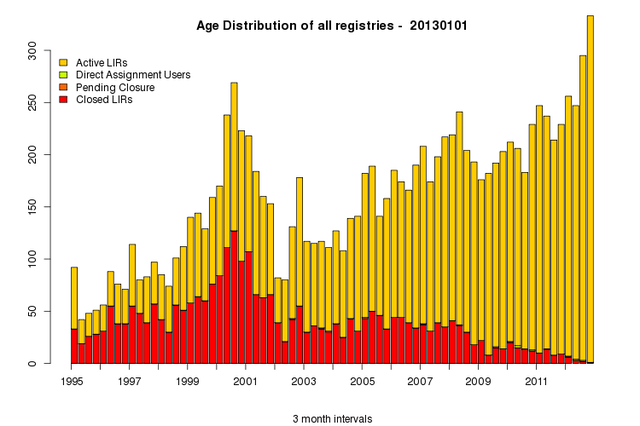
Figure 1: Number of LIRs and their current state vs. the quarter they joined
It is interesting to note that even though we are now allocating from the last /8 of IPv4 addresses under a different policy, the number of weekly IPv4 allocations remains roughly the same, as the green line in Figure 2 indicates. The blue line shows the number of IPv4 assignments which, except for the special cases of Internet Exchange Points and temporary assignments, stopped when we started using the last /8.
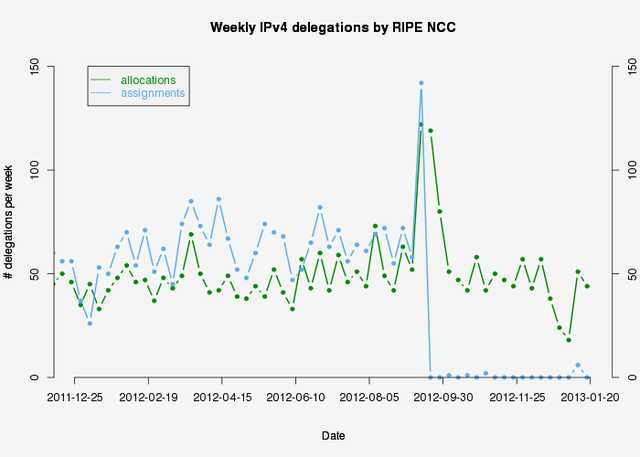
Figure 2: Number of IPv4 allocations (green) and assignments (blue) per week
As expected and shown in Figure 3 below, the total number of IPv4 addresses allocated has dropped significantly after reached the last /8. This is because an LIR can only get one single /22 allocation from the remaining pool of IPv4 addresses at the RIPE NCC.
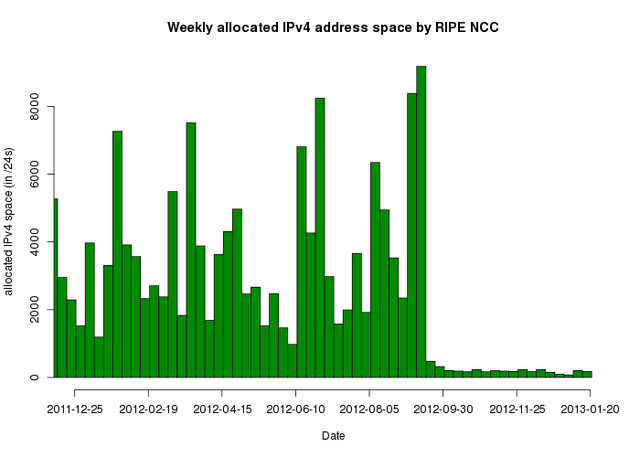
Figure 3: Number of IPv4 addresses allocated per week
At the same time, the rate of IPv6 allocations increased significantly upon reaching the last IPv4 /8. The green line in Figure 4 shows this. As described in an earlier article, that increase is likely caused by the last /8 policy which requires LIRs to have an IPv6 allocation before they can receive IPv4 address space from the last /8.

Figure 4: Number of IPv6 allocations (green) and assignments (blue) per week
The actual number of addresses handed out as part of these allocations increased as well (see Figure 5). The main cause here is the policy which allows members to request a /29 as inital IPv6 allocation . This has been implemented mid 2012. Since then about 30% of LIRs have requested that their initial IPv6 allocation be a /29 instead of the default /32.
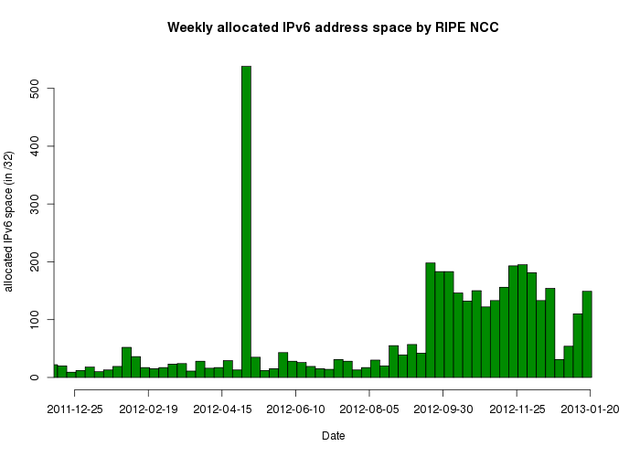
Figure 5: Number of IPv6 addresses allocated per week
The increase in IPv6 allocations also shows up in IPv6 RIPEness : at the end of 2012 about 56% of LIRs had one or more stars. In Figure 6 we can see the last two quarters really standing out. However, the biggest increase is seen in the 1-star category (the yellow bar). Again, this can be attributed to the last /8 policy. Many of the new LIRs get their IPv6 allocation, but in comparison to older LIRs only a small part of them take any of the next steps to a higher IPv6 RIPEness rating (i.e. announce the IPv6 prefix, register a route6 object in the RIPE Database and set up reverse DNS of the IPv6 prefix).

Figure 6: IPv6 RIPEness of active LIRs vs. the quarter they joined
It is worth mentioning that members in the Middle East and in Eastern Europe are still a bit underrepresented in IPv6: LIRs in Eastern Europe make up 29% of all active LIRs, but only hold 25% of IPv6 allocations. Similar for the Middle East: 7.5% of all LIRs come from that region, but they hold only 5.8% of all IPv6 allocations.
Finally, we looked at the growth in membership in certain countries or regions and observed an increase in members in Eastern Europe and Russia:
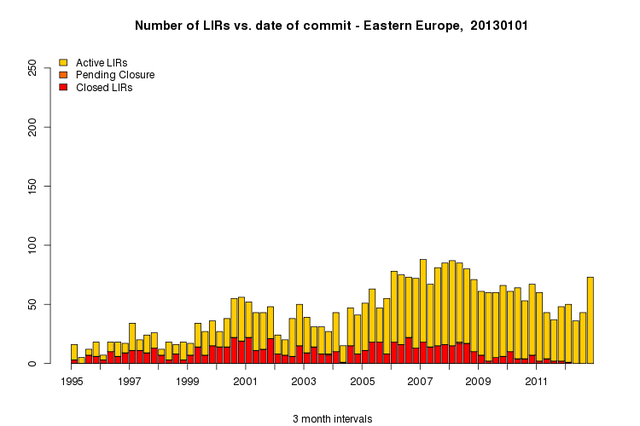
Figure 7: Number of LIRs in Eastern Europe per quarter
Since the start of the financial crisis, the rate of Eastern European LIRs joining the RIPE NCC had been declining slowly. The last quarter of 2012 broke with that trend. The number of LIRs that signed up in these months is almost as high as seen in the peak years 2006-2008.
In Western Europe the number of new LIRs increased too, starting already in Q3 of 2012 as shown in Figure 8. The upward trend in this region has been observed since 2002; however, the rates in the second half of 2012 exceed what one could have expected from simple exrapolation.

Figure 7: Number of LIRs in Western Europe per quarter
Conclusion
Reaching the last /8 of IPv4 addresses went fairly smoothly in the RIPE NCC service region. No big last minute rush was observed. Since then we observe a steady stream of requests for the remaining IPv4 address space and an increased rate of new LIRs joining the RIPE NCC.
We also see an increase in IPv6 allocations, likely because of the requirements for requesting address space from the last /8. The intention behind this policy is to encourage the use of IPv6. Although the policy does indeed get the addresses to the LIRs, steps towards further deployment do not seem to be taken as quickly as we would like to see.
For more statistics, please see the RIPE NCC Statistics Dashboard .

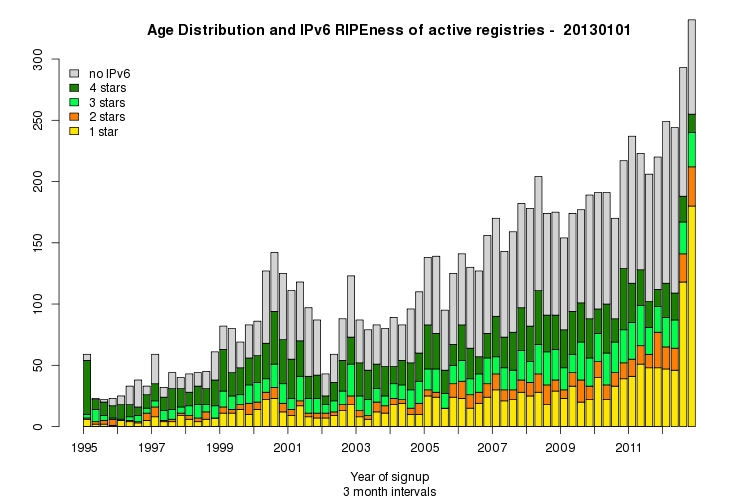

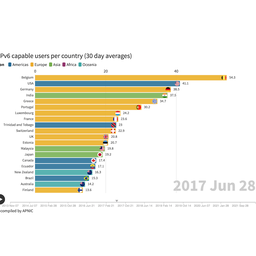
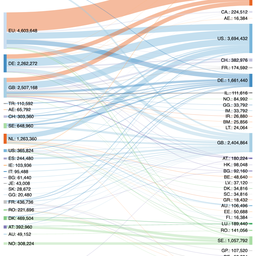
Comments 0
The comments section is closed for articles published more than a year ago. If you'd like to inform us of any issues, please contact us.